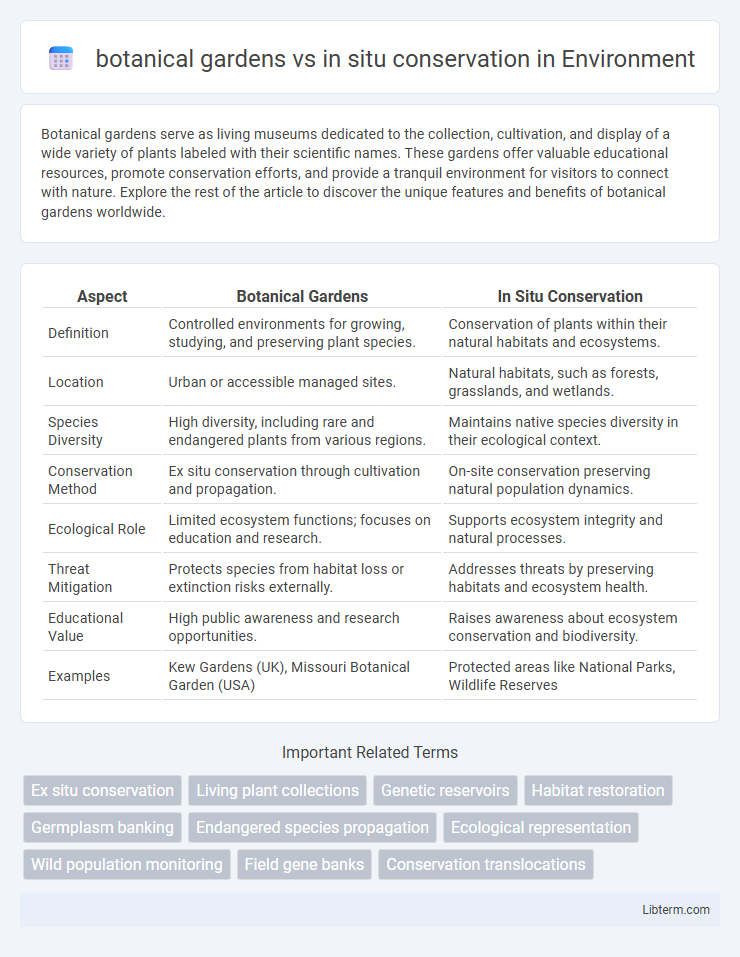Botanical gardens serve as living museums dedicated to the collection, cultivation, and display of a wide variety of plants labeled with their scientific names. These gardens offer valuable educational resources, promote conservation efforts, and provide a tranquil environment for visitors to connect with nature. Explore the rest of the article to discover the unique features and benefits of botanical gardens worldwide.
Table of Comparison
| Aspect | Botanical Gardens | In Situ Conservation |
|---|---|---|
| Definition | Controlled environments for growing, studying, and preserving plant species. | Conservation of plants within their natural habitats and ecosystems. |
| Location | Urban or accessible managed sites. | Natural habitats, such as forests, grasslands, and wetlands. |
| Species Diversity | High diversity, including rare and endangered plants from various regions. | Maintains native species diversity in their ecological context. |
| Conservation Method | Ex situ conservation through cultivation and propagation. | On-site conservation preserving natural population dynamics. |
| Ecological Role | Limited ecosystem functions; focuses on education and research. | Supports ecosystem integrity and natural processes. |
| Threat Mitigation | Protects species from habitat loss or extinction risks externally. | Addresses threats by preserving habitats and ecosystem health. |
| Educational Value | High public awareness and research opportunities. | Raises awareness about ecosystem conservation and biodiversity. |
| Examples | Kew Gardens (UK), Missouri Botanical Garden (USA) | Protected areas like National Parks, Wildlife Reserves |
Introduction to Botanical Gardens and In Situ Conservation
Botanical gardens serve as controlled environments for the cultivation, study, and preservation of diverse plant species, often focusing on rare and endangered flora. In situ conservation involves protecting plants within their natural habitats, maintaining ecosystem integrity and promoting natural evolutionary processes. Both approaches are essential for preserving biodiversity, with botanical gardens providing ex situ backup populations and in situ conservation ensuring habitat-specific survival.
Defining Botanical Gardens: Features and Functions
Botanical gardens are curated spaces dedicated to the cultivation, study, and display of a wide variety of plant species, serving educational, scientific, and conservation purposes. These gardens provide controlled environments for ex situ conservation, allowing for the preservation of rare and endangered plants outside their natural habitats. Key features include labeled plant collections, research facilities, public engagement programs, and seed banks, which collectively support biodiversity conservation and awareness.
Understanding In Situ Conservation: Principles and Practices
In situ conservation involves protecting plant species within their natural habitats, preserving the intricate ecological relationships and evolutionary processes essential for long-term survival. Botanical gardens complement this by maintaining ex situ collections that support research, education, and restoration efforts but lack the dynamic environmental interactions found in natural settings. Understanding in situ conservation principles centers on habitat protection, sustainable management, and monitoring to maintain biodiversity and ecosystem resilience.
Biodiversity Preservation: Ex Situ vs. In Situ Approaches
Botanical gardens play a crucial role in biodiversity preservation through ex situ conservation by maintaining living collections of rare and endangered plant species outside their natural habitats, enabling controlled propagation and research opportunities. In situ conservation preserves biodiversity directly within natural ecosystems, allowing species to evolve in response to environmental changes and maintaining ecological interactions essential for ecosystem health. Combining ex situ methods like botanical gardens with in situ strategies enhances overall conservation effectiveness by safeguarding genetic diversity and supporting ecosystem resilience.
Conservation Success Stories: Botanical Gardens
Botanical gardens serve as critical reservoirs for endangered plant species, successfully preserving genetic diversity and facilitating the reintroduction of rare flora into native habitats. Cases such as the conservation of the Wollemi pine in Australia demonstrate how ex situ collections in botanical gardens have prevented extinction and supported habitat restoration. These institutions also enhance public awareness and scientific research, complementing in situ efforts by safeguarding species vulnerable to environmental threats.
Ecological Benefits of In Situ Conservation
In situ conservation preserves ecosystems and natural habitats, maintaining species interactions, genetic diversity, and ecological processes essential for ecosystem resilience. It supports adaptation to environmental changes by allowing species to evolve naturally within their native environment. This method safeguards entire ecosystems, promoting long-term sustainability and biodiversity conservation more effectively than ex situ approaches like botanical gardens.
Research, Education, and Public Engagement
Botanical gardens offer controlled environments for comprehensive research on plant propagation, genetics, and adaptation, supporting conservation efforts that complement in situ strategies. In situ conservation preserves plants within their natural habitats, enabling the study of ecological interactions and evolutionary processes critical for ecosystem stability. Both approaches leverage education and public engagement by fostering awareness, promoting biodiversity, and encouraging community involvement in plant conservation initiatives.
Challenges and Limitations of Both Methods
Botanical gardens face challenges such as limited genetic diversity, high maintenance costs, and vulnerability to diseases and pests in controlled environments. In situ conservation struggles with habitat destruction, climate change impacts, and difficulties in enforcing protective regulations within natural ecosystems. Both methods require comprehensive strategies integrating ex situ and in situ approaches to effectively preserve plant biodiversity amid environmental and socio-economic pressures.
Integrating Botanical Gardens with In Situ Strategies
Integrating botanical gardens with in situ conservation strategies enhances biodiversity preservation by combining ex situ plant cultivation with habitat protection and restoration efforts. Botanical gardens serve as genetic reservoirs and research hubs, supporting reintroduction programs and complementing on-site conservation of endangered species in their natural ecosystems. This synergy improves resilience against climate change and habitat loss by promoting sustainable plant management across multiple landscapes.
The Future of Plant Conservation: Collaborative Solutions
Botanical gardens play a crucial role in ex situ conservation by maintaining living plant collections and supporting research on endangered species, complementing in situ efforts that protect plants within their natural habitats. Collaborative solutions involving both botanical gardens and in situ conservation initiatives enhance genetic diversity preservation and promote ecosystem resilience. Integrating advanced technologies and community engagement fosters a sustainable future for plant conservation worldwide.
botanical gardens Infographic

 libterm.com
libterm.com